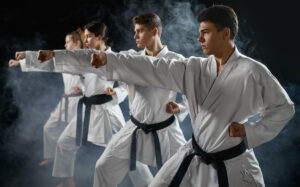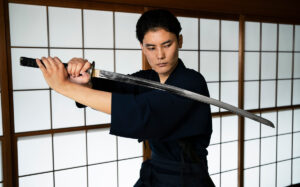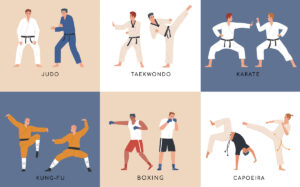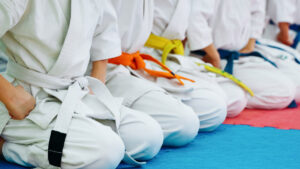Curious about martial arts in the Olympic Games? You’re not alone! It’s important to know that currently, seven distinct martial arts have made their mark on the world’s most significant sports stage.
This blog is your definitive guide to understanding which martial arts are included in the Olympics, how they evolved over time, and what it means for athletes practicing these disciplines.
Let’s dive into this fascinating world where discipline meets strength.
Key Takeaways
- Seven martial arts are in the Olympics. They are Boxing, Fencing, Judo, Karate, Taekwondo and Wrestling with Greco Roman’s style.
- Each sport has different events and rules. Players get points for hitting or pinning foes.
- Martial arts in the Olympics can change over time. New styles might be included and some current ones may go out.
- Being part of the Olympics is a big deal for sports like these – it helps boost popularity all over our world!
Martial Arts in the Olympics
The Olympics showcase a diverse range of martial arts, including Boxing, Fencing, Judo, Karate, Taekwondo and Wrestling. Each martial art presents its unique technique with athletes from around the world competing for gold.
Greco Roman Wrestling also holds a prominent position in this prestigious global event. The list is dynamic and sometimes includes additional disciplines based on the host country’s preference or new developments in the sporting world.
Boxing in the Olympics

Boxing is one of the most popular sports worldwide and plays a significant role in the Olympic Games. Its origins in the Games trace back to 648 BCE in Ancient Greece when participants battled each other with strips of leather wrapped around their fists, aiming to deliver more blows or even render their opponent unconscious.
The sport underwent significant changes in the 19th century in Great Britain when the official boxing rules were introduced. Notably, the use of gloves became a mandatory part of the sport. Boxing has been a staple of the modern Olympic Games since its inclusion in St. Louis in 1904, with the exception of the 1912 Olympics in Stockholm. It’s worth noting that women’s boxing was only introduced to the Olympic lineup in 2012 during the London Games.
The Rules of Olympic Boxing
Boxing matches at the Olympic Games consist of three rounds, each lasting three minutes. Fighters must adhere to specific regulations during their bouts:
- 3 Rounds (3 Minutes Each)
- Ways To Win: KO/TKO, Decision, or DQ (No Draws Allowed)
- Punches are only allowed above the waist.
- Fighters can only punch the front of their opponent’s body.
A match can conclude prematurely for various reasons, including a significant skill difference between the fighters, a boxer being unable to continue for 10 seconds (resulting in a KO), medical intervention, or if a fighter receives three warnings leading to disqualification.
Weight Classes
The 2021 Olympic Games in Tokyo showcased men competing in eight different weight classes and women in five:
Men’s Weight Classes:
- Flyweight (105.8-114.6 pounds)
- Featherweight (114.6-125.6 pounds)
- Lightweight (125.6-138.9 pounds)
- Welterweight (138.9-152.1 pounds)
- Middleweight (152.1-165.3 pounds)
- Light heavyweight (165.3-178.6 pounds)
- Heavyweight (178.6-200.6 pounds)
- Super heavyweight (+200.6 pounds)
Women’s Weight Classes:
- Flyweight (105.8-112.4 pounds)
- Featherweight (119-125.6 pounds)
- Lightweight (125.6-132.3 pounds)
- Welterweight (141.1-152.1 pounds)
- Middleweight (152.1-165.3 pounds)
Olympic Boxing Achievements
The United States stands as the most successful country in Olympic boxing, boasting 114 medals, with 50 being gold. Following closely are Cuba with 73 medals (37 gold) and Great Britain with 56 medals (18 gold). Many boxers have used the Olympic platform to launch incredibly successful professional careers, including legendary figures like Lennox Lewis, Evander Holyfield, Joe Frazier, George Foreman, Floyd Mayweather, Anthony Joshua, and Muhammad Ali.
Fencing at the Olympics
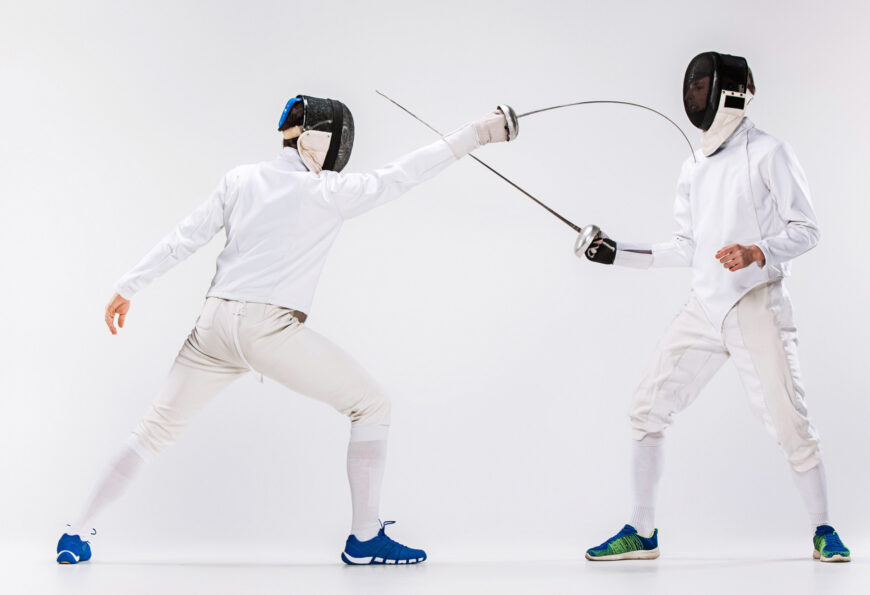
Fencing, one of the key martial arts featured at the Olympics, is not just about strength but also about speed, aim, and strategic thinking. Since its introduction at the 1896 Games in Athens, fencing has been an integral part of the Olympic experience. Women made their Olympic fencing debut in the 1924 Paris Games, further expanding the sport’s reach and diversity.
This sport employs three distinct types of weapons: the foil, the epée, and the saber. While they might look similar to the untrained eye, each has its unique characteristics and target areas:
- Foil: Fencers target the torso, including the back.
- Epée: The entire body is the target area.
- Saber: Fencers aim for the torso, head, and arms.
When a fencer hits the target area, lamps light up on electrical scoring machines, signifying a point. This innovative system ensures accurate and quick scoring.
For individual foil and epée events, fencers engage in a battle of wits and skill for three rounds, each lasting three minutes. The victor is either the first to secure 15 points or the one with the most points once time runs out. In case of a tie, a sudden-death overtime determines the winner, with the first to score emerging triumphant.
On the other hand, team events feature three primary members, alongside a reserve. These teams compete in a round-robin format where every fencer faces every opponent from the opposing team.
Olympic Fencing Disciplines:
- Individual foil (men/women)
- Individual epée (men/women)
- Individual saber (men/women)
- Team foil (men/women)
- Team epée (men/women)
- Team saber (men/women)
Apart from the competitive aspect, fencing teaches its practitioners focus, quick thinking, and rapid decision-making. With mere seconds to react, players must continually anticipate and counter their opponent’s moves, making it a captivating sport for both participants and spectators
Judo in the Olympics
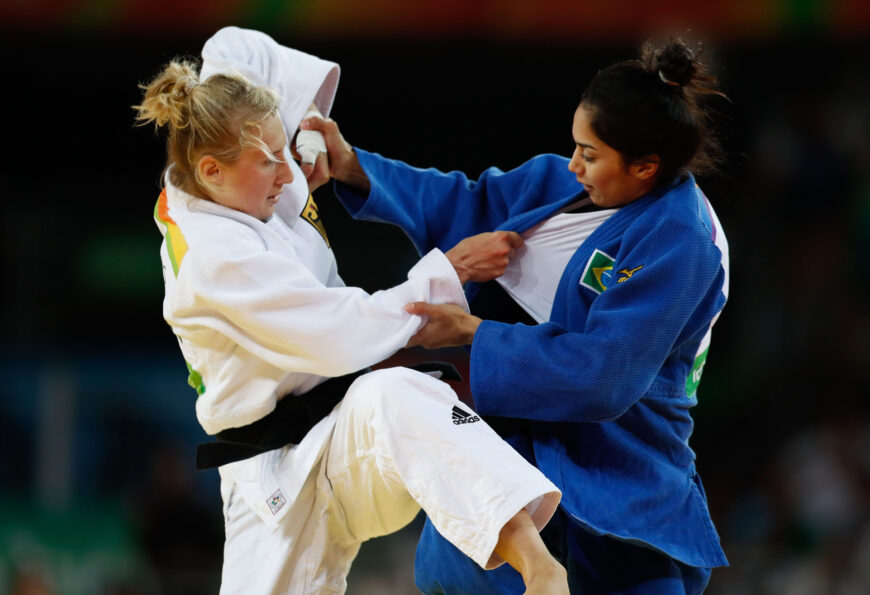
Judo is a revered part of the Olympic Games. Having made its Olympic debut in 1964 during the Tokyo Games, it marked a significant moment in the world of martial arts. Interestingly, the creator of Judo, Grandmaster Jigoro Kano, played an instrumental role in the Olympics as the first Asian committee member. He held this esteemed position until he passed away in 1938. His martial art would grace the Olympic platform in 1964. While it was excluded from the 1968 games, Judo made a comeback in 1972 and has since maintained its standing for over 50 years.
In the evolution of Judo in the Olympics, women’s divisions were introduced later, in 1992, during the Barcelona Olympics. Athletes who participate in Judo events proudly wear the title of Judoka.
Objective and Techniques
The core principle of Judo is to use techniques, both offensive and defensive, to either throw or take down an opponent. The ultimate goal is to pin, immobilize, or make them submit through a choke or joint lock. With 100 techniques available to practitioners, Judo showcases 68 throwing techniques (nagewaza) and 32 grappling techniques (katamewaza).
Scoring and Match Rules
Judo matches are not just about force but also technique and strategy. Points are awarded for successfully using techniques against opponents. Winning can be achieved through different ways:
- Ippon: Throwing the opponent so they land flat on their back
- 2 Waza Aris: Achieving two scores lesser than Ippon but significant enough
- Hansoku Penalty: When the opponent is disqualified
- 4 Shido Penalties: Accumulation of minor fouls
Should a match end with a tie in points, it advances to the “Golden Score” or overtime. In this stage, the first Judoka to score secures the victory. Match durations are 5 minutes for men and 4 minutes for women.
Weight Classes
At the Tokyo 2021 Olympics, male Judokas competed in the following weight classes:
- 132.3 pounds (-60 kg)
- 145 pounds (-66 kg)
- 161 pounds (-73 kg)
- 178.6 pounds (-81 kg)
- 198.4 pounds (-90 kg)
- 220.5 pounds (-100 kg)
- +220.5 pounds (+100 kg)
Female Judokas had these divisions:
- 105.8 pounds (-48 kg)
- 114.6 pounds (-52 kg)
- 125.7 pounds (-57 kg)
- 138.9 pounds (-63 kg)
- 154.3 pounds (-70 kg)
- 172 pounds (-78 kg)
- +172 pounds (78 kg)
Leading Nations in Olympic Judo
Japan, being the birthplace of Judo, unsurprisingly holds the record for the most Olympic medals in the sport, boasting 84 in total, with 39 gold. They are closely followed by France with 49 medals (14 gold), and then South Korea with 43 medals (11 gold).
With its rich history and intense competition, Judo remains one of the most popular events in the Olympics, drawing spectators from all over the world.
Karate in the Olympics
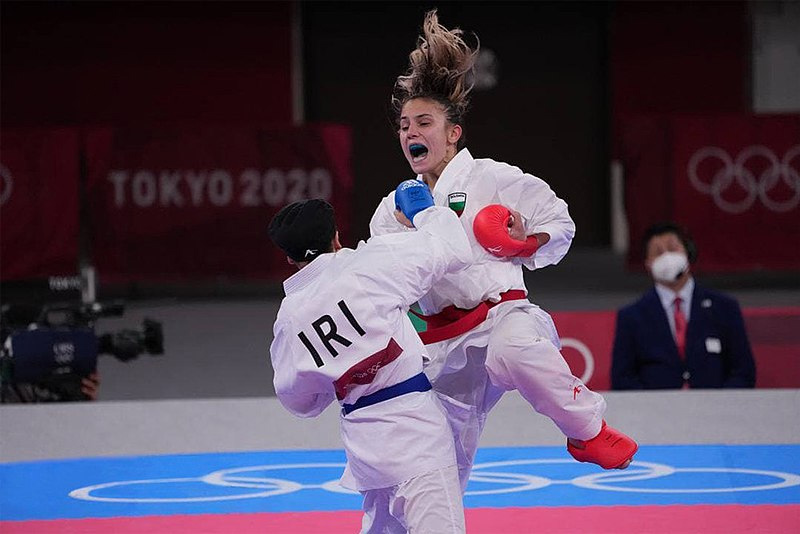
Karate, originating from Japan and meaning “empty hand,” was introduced as an official Olympic sport at the Tokyo Games in 2021, although it was initially meant to debut in the 2020 Olympic Games that were postponed due to Covid-19. There are two types of competitions in Olympic Karate – kata and kumite.
In Kata, practitioners demonstrate a set of offensive and defensive maneuvers against a virtual opponent. Competitors have the liberty to choose which kata they will present before the judges. The winners are determined through a points-based system.
Kumite pits two practitioners against each other in a sparring format. The objective is to land blows on the target areas of the opponent’s body. A match consists of a single 3-minute round, and the first fighter to amass an eight-point lead over the opponent within this timeframe emerges as the victor. In case of a tie, the contender who scores the first points wins. However, if no points are awarded throughout the bout, the judges decide the winner. Scoring in Kumite is as follows:
- Yuko: 1 Point for body punches.
- Waza-Ari: 2 Points for body kicks.
- Ippon: 3 Points for head kicks or any technique where the opponent falls.
Athletes adorn a Karate Gi and are equipped with protective gear including headgear, shin guards, chest protector, and foot guards.
Taekwondo in the Olympics
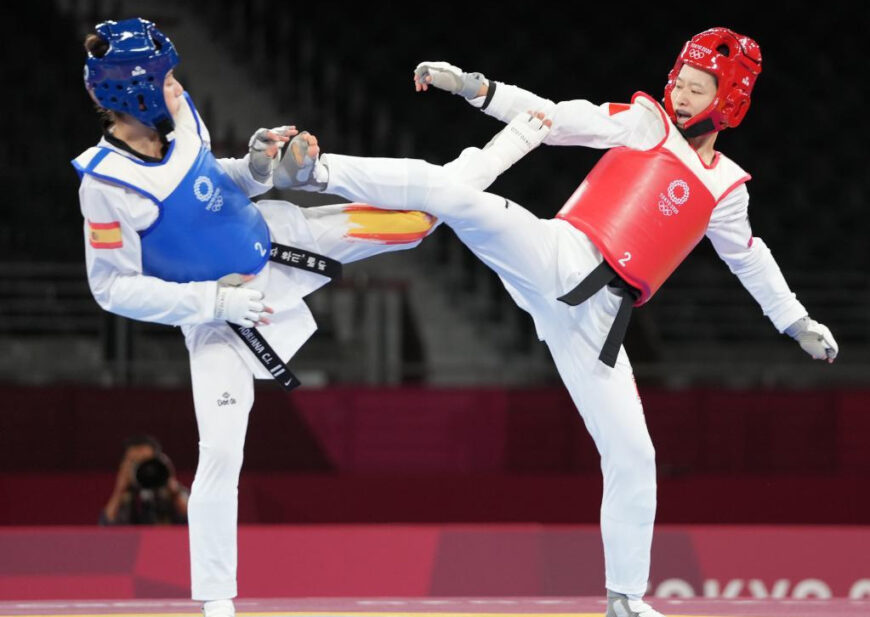
Originating from Korea, Taekwondo is a martial art emphasizing kicks and punches. It first made its appearance as a demonstration sport at the 1988 Olympics in Seoul, and by 2000, it became an official Olympic sport. Today, Taekwondo boasts over 70 million practitioners globally.
Olympic Taekwondo matches consist of three 2-minute rounds. Players score points by making impactful contact on their opponent’s head or torso using precise foot techniques. The scoring system is as follows:
- Punches: 1 Point.
- Kicks to the body: 2 Points.
- Head kicks: 3 Points.
- Turn kicks to the head: 5 Points.
The PSS (Protector and Scoring System) was introduced in the 2012 London Games to assist in scoring. This system has electronic sensors embedded in the athlete’s protective gear which is wirelessly linked to an electronic scoreboard. Judges can also manually award points, especially for technical maneuvers like spinning kicks which earn extra points. The attire includes a headgear, chest protector, Taekwondo gloves, shin guards, and foot guards.
Wrestling
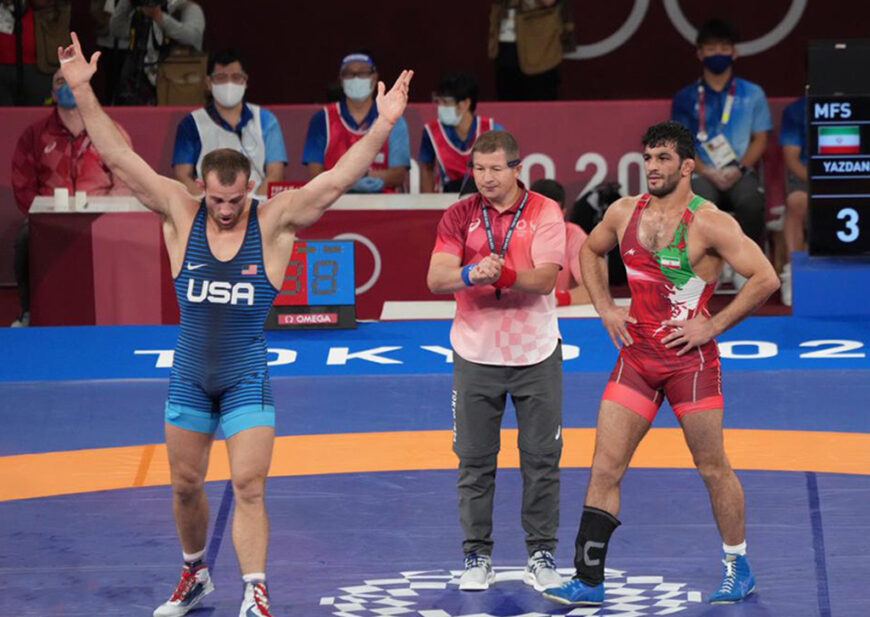
Wrestling, one of the oldest known sports, was introduced to the Olympics back in 708 BCE. Modern Olympics have showcased two types of wrestling: Greco-Roman, which was added in 1896, and Freestyle, introduced in 1904. Women’s freestyle wrestling debuted in 2004.
The primary objective in both styles is to press both of the opponent’s shoulders onto the mat. While Greco-Roman restricts players to using only their upper body and arms, Freestyle wrestling permits takedowns and throws above the waist.
Freestyle wrestling gained its Olympic presence after the Olympic committee decided against including catch wrestling due to potential injuries from submissions. The first freestyle wrestling Olympic event in 1904 saw only American participants, but the sport’s popularity rapidly grew, making it the most practiced form of wrestling globally.
Both men and women participate in various weight classes in the Olympic wrestling events. The two styles share many rules, but the most notable difference is that in freestyle, takedowns and throws above the waist are allowed.
Greco Roman Wrestling
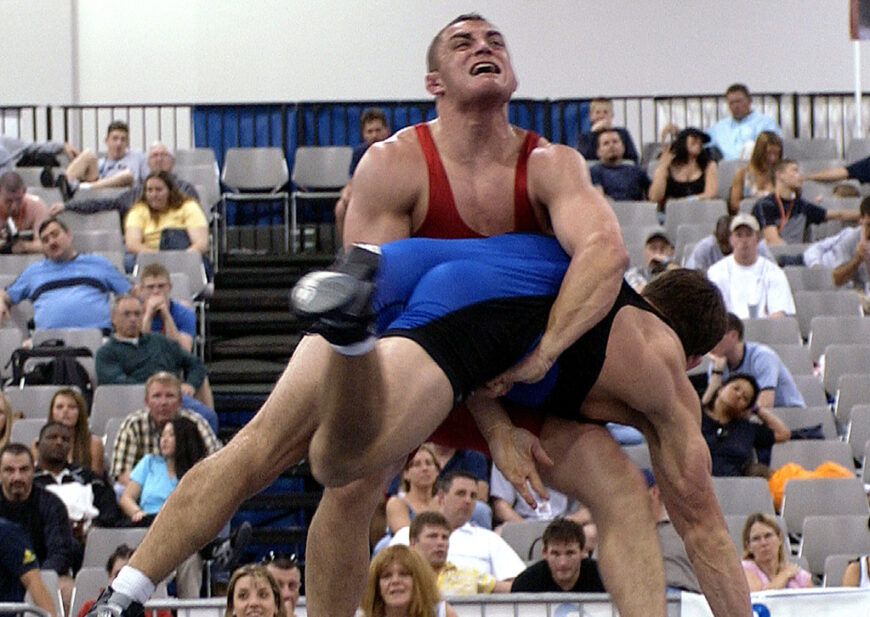
Greco Roman Wrestling is a distinguished sport with deep roots in Olympic history. It stands out distinctly from other styles of wrestling due to its unique set of rules and techniques. Wrestling in general has been a cornerstone of the Olympics, and the Greco Roman style, in particular, has solidified its place since its debut.
Historical Significance
Greco-Roman wrestling was one of the original Olympic sports when the modern Olympics were reintroduced in 1896. Its inclusion was a natural choice, given that the ancient Olympics had wrestling events and, during that period, Greco-Roman wrestling was the predominant and most popular style. Over the past century, it has seen numerous champions, leaving an indelible mark on the history of Olympic martial arts. Its prominence has undoubtedly paved the way for the introduction of other martial arts in the Olympics.
Key Features of Greco Roman Wrestling
- Unlike other wrestling types, in Greco Roman Wrestling, competitors can only use their upper body to trap and pin their opponent. The use of legs for offense or defense, such as tripping or using them to secure a hold, is strictly prohibited.
- Competitors must maintain their weight on two feet throughout the match. This requires not only raw power in the arms and chest but also strategic gameplay to overcome opponents.
- Many aficionados appreciate the style for its sheer toughness, technique, and the balance of physical and mental prowess it demands.
Rules of Greco Roman Wrestling in the Olympics
- The match consists of 2 periods, each lasting 3 minutes.
- Wrestlers don a uniform comprising wrestling singlets and shoes.
- Takedowns are permitted only above the waist.
- Victory can be achieved through pin, points, or disqualification (DQ).
- A lead of 8 points will result in an automatic win for the leading wrestler.
- Points allocation:
- Takedowns: 2-5 points
- Reversal: 1 point
- Exposure (making your opponent’s back vulnerable): 2-3 points
- Penalties: 1-2 points
- Going out of bounds: 1 point
For those who watch, Greco Roman Wrestling is not just a display of physical strength but also a testament to the strategic thinking of the wrestlers. It remains a fascinating spectacle and a legacy sport in the Olympics.
Additional martial arts (if any)
In past Olympics, Muay Thai and Capoeira were showcased but weren’t official events. People loved them. They may join the list soon. Many wish for Kendo and kickboxing to find their place in future Games too.
History and Significance of Olympic Martial Arts
This section delves into the evolution of martial arts in the Olympic Games, underlining their cultural and historical significance as well as their influence on global recognition and popularity.
Evolution of martial arts in the Olympic Games
Martial arts started in the Olympics long ago. Wrestling was first seen in 708 BC. Over time, more sports joined in. Boxing came to be a part of the Games.
In recent times, new martial arts have been added. Tae kwon do became an Olympic sport not too long ago. For the 2020 Tokyo Olympics, karate was also included. So over time, martial arts keep growing and changing much like the Olympic Games themselves.
Cultural and historical importance
Martial arts hold a great place in our past. Wrestling was in the first ancient Olympic games. It started in 708 BC! This tells us how old martial arts are and their role in culture goes back far.
Today, they stay an important part of the Olympic sports mix. Martial arts from different parts give world flavor to the Olympics. Taekwondo brings Korean history to life on the mat.
Judo shares values from Japanese way of thinking with people watching around the globe. Boxing shows off grit seen throughout time across many lands.
Impact on global recognition and popularity
The Olympics make martial arts famous all over the world. Lots of people watch the games. They see athletes from different countries compete. This helps put martial arts in the spot light.
Being a part of the Olympics is a big deal for any sport, including martial arts. It gives athletes a chance to show off their skills on an international stage. Many learn about these sports for the first time during the event.
This leads to increases in popularity and recognition worldwide after every Olympic Games.
Olympic Events and Rules for Each Martial Art
This section explores the specific event structures and regulations for each Olympic martial art, including divisions based on weight classes, scoring systems and judging criteria.
We will also delve into the eligibility requirements and qualification processes that athletes must adhere to in order to compete at this prestigious level.
Weight classes and divisions
In Olympic martial arts, weight classes split athletes into groups. This makes sure fights are fair. Two people who weigh the same will fight each other. Each kind of martial art at the Olympics has its own set of weight classes.
For Judo, there are seven weight classes for men and women both. Boxing and wrestling have eight for men and five for women. Taekwondo has four divisions per gender while Karate only has three.
Weight splits depend on the sport’s rules. By keeping athletes in their own class, everyone gets an equal chance to win a medal at game time!
Scoring systems and judging criteria
In each martial art, athletes earn points in different ways. Some score for punches and kicks like boxing and taekwondo. Others award wrestlers for pins or throws like judo. Karate players punch, kick, or strike to gain points as well.
Each hit must be fast, precise and strong. In fencing, the fencer who first strikes the opponent with their weapon gets a point. Judges watch carefully to spot fouls that could cost an athlete points too.
They make sure every match is fair and safe.
Athlete eligibility and qualification process
To play in the Olympics, martial artists must prove they are the best. They have to score high points at world events. Each sport has a different way to pick players. New athletes join by winning games and earning slots for their countries.
Some spots go to top-ranked stars from World Championships or Continental Games. The process is tough but fair so that only the most skilled get to compete on this grand stage.
Future Changes in Olympic Martial Arts
The future of Olympic martial arts brims with possibilities, ranging from potential additions of new types or styles to adaptations that echo modern trends. Martial arts at the Olympics could also become a platform championing diversity and inclusion in global sport.
For an insider look into these exciting developments, keep reading our comprehensive review.
Potential additions or removals
Changes might happen in the martial arts listed for the Olympics. Some sports may be left out, some new ones may come in. For example, boxing has faced problems lately. It might not be at the 2024 Paris Olympics.
We could see new events soon, too! Capoeira and Muay Thai would bring fresh energy to the Games. Yet nothing is sure right now and we need to wait and watch what happens next!
Adaptation to modern trends and styles
Martial arts in the Olympics are changing. They fit new styles and trends now. For example, karate and taekwondo use tech for fair scores. Fans at home also see these changes on TV.
The look of martial arts is better now too. New clothes match each sport’s style and ways better than old ones do. This helps athletes feel good as they fight for a win at the Olympics.
Promotion of diversity and inclusivity
The Olympics give everyone a fair chance. Men and women from different lands can join in. The doors are open for all. It does not matter your race or age, you can be part of it too! The games show that people who seem very different can share one goal.
By doing so, they share their unique skills with the world. Martial arts in the Olympics helps us learn about many cultures we may not know enough about yet. We see styles from every corner of our globe when martial artists take the stage at these games.
It makes us feel closer as a worldwide family to watch them compete together on this big stage.
Benefits of Martial Arts in the Olympics
Martial arts in the Olympics foster athlete development by providing a platform for international competition. They promote physical fitness and mental discipline through rigorous training and performance standards.
Additionally, these events serve as an inspiration for aspiring martial artists around the world fostering dreams of Olympic glory and recognition in their chosen combat discipline.
Athlete development and international competition opportunities
Being in the Olympics helps martial artists grow. They learn new skills and get better at their sport. Many martial artists around the globe dream about this. The Olympics is a big stage to show off their talents.
Also, they get to meet players from other countries. This helps them learn new styles and techniques of martial arts. It opens doors for athletes from all over the world. Everyone gets a fair chance to win medals for their country.
Promotion of physical fitness and mental discipline
Martial arts in the Olympics help boost physical fitness and mental discipline. The sports are tough. They need a mix of speed, strength, and stamina. This leads to excellent body health.
Martial arts also train your mind. Athletes learn focus and control. They have to make quick moves with no error. It’s not just about brutal force but smart strategy too! Being a part of these events boosts self-discipline greatly! No sport does it better than martial arts at the Olympics.
Inspiration for aspiring martial artists
Martial arts in the Olympics inspire many young people. They see top athletes from around the world compete. This makes them want to learn and be like them one day. Some kids start training right after watching matches on TV or online.
It’s not easy but they keep going because of their Olympic heroes. Their dream is to stand tall on an Olympic stage one day, too! Trainers use Olympians as examples during training sessions to motivate them further.
Thus, martial arts at these games help shape future stars and keep traditions alive.
Controversies and Challenges in Olympic Martial Arts
This section delves into the debates and difficulties surrounding Olympic martial arts, addressing contentious issues such as scoring discrepancies, the inclusion or exclusion of certain disciplines, and safety concerns to ensure fairness for all athletes.
Issues with judging and scoring
There are fights about scoring and judges in Olympic martial arts. Sometimes, a judge may miss an important move. This can change the score. The official who makes these choices is human too.
They might make a mistake.
People also think there is bias in scoring or judging sometimes. A judge may feel good about one style of fighting over another by nature. Their personal thoughts could play into how they score a match.
Debate over inclusion of certain martial arts
Some people don’t like certain sports being in the Olympics. They think they are not real martial arts. Some of these sports are fencing and boxing. People also talk about new kinds of fighting that could be in the future games.
Mixed Martial Art (MMA) is one of them. Some folks want it to become part of the Olympic Games too! But others say it’s too dangerous or doesn’t fit with other Olympic events. Yet, some martial artists believe all types should have a spot in these global games.
Addressing concerns about safety and fairness
Keeping fighters safe is a big deal. Olympic games have rules to make sure no one gets hurt too bad. This helps keep the fights fair too. The same rules apply to all players, no matter where they are from.
Also, skilled judges watch every fight closely. They make decisions and score based on what they see happen in each match. Players who break the rules can get points taken away or even be thrown out of a game!
FAQs
1. What are the martial arts in the Olympics?
The martial arts in the Olympics include Judo, Taekwondo, Karate and Boxing.
2. Was Karate a part of all Olympic games?
No, Karate was only included for the first time in the 2020 Tokyo Summer Olympics.
3. Is Kung Fu present in the Olympic Games?
No, Kung Fu is currently not officially part of any Olympic Games events.
4. Has wrestling always been a part of the Olympics?
Yes, Wrestling has been a part of almost all ancient and modern Olympic games with Greco-Roman style being one of its variants.
5. Are there any team sports in martial arts at The Olympics?
Yes, Team Sports such as Judo have a team event which is considered to be very prestigious.
Conclusion
The Olympic Games continue to evolve, and martial arts have carved out a firm place in this prestigious global event. From the ancient origins of wrestling to the recent introduction of karate, these disciplines highlight the diverse range of combat sports practiced worldwide. While debate and controversy occasionally surface, the overall benefits are clear. Martial arts in the Olympics promote athletic excellence, cultural exchange, and inspiration for youth. As we look ahead, it is certain that Boxing, Fencing, Judo, Karate, Taekwondo and Wrestling with Greco Roman’s style will continue playing a vital role in the spirit and legacy of the Olympics.




